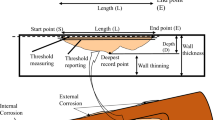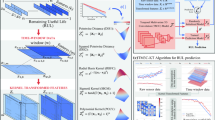Abstract
Because the clogging of filters leads to degradation and failure of mechanical systems, it is important to assess the health condition of a filter and predict its remaining useful life (RUL). Despite prior studies of liquid filtration systems, adequate attention has not been paid to data-driven health condition and RUL prognosis. Therefore, this study suggests a data-driven prognosis approach for liquid filtration systems. We define a health index (HI) for the filter under study and then predict HI values from the degradation point to the end-of-life using recurrent neural network algorithms, thereby yielding the filter’s RUL. As a result, the bidirectional LSTM achieved the best performance, and the RUL measured through HI prediction was close to the actual RUL. The proposed approach can be used for the maintenance of liquid filtration systems in various industries.
Similar content being viewed by others
References
O. F. Eker, F. Camci and I. K. Jennions, Physics-based prognostic modelling of filter clogging phenomena, Mechanical Systems and Signal Processing, 75 (2016) 395–412.
R. Kristiansen, Sand-filter trenches for purification of septic tank effluent: I. The clogging mechanism and soil physical environment, Journal of Environmental Quality, 10(3) (1981) 353–357.
A. Grall, C. Bérenguer and L. Dieulle, A condition-based maintenance policy for stochastically deteriorating systems, Reliability Engineering and System Safety, 76(2) (2002) 167–180.
J. Zhang and J. Lee, A review on prognostics and health monitoring of Li-ion battery, Journal of Power Sources, 196(15) (2011) 6007–6014.
X. Jia, C. Jin, M. Buzza, Y. Di, D. Siegel and J. Lee, A deviation based assessment methodology for multiple machine health patterns classification and fault detection, Mechanical Systems and Signal Processing, 99 (2018) 244–261.
G. W. Vogl, B. A. Weiss and M. Helu, A review of diagnostic and prognostic capabilities and best practices for manufacturing, Journal of Intelligent Manufacturing, 30(1) (2019) 79–95.
O. Fink, Q. Wang, M. Svensén, P. Dersin, W.-J. Lee and M. Ducoffe, Potential, challenges and future directions for deep learning in prognostics and health management applications, Engineering Applications of Artificial Intelligence, 92 (2020) 103678.
X. Jia, B. Huang, J. Feng, H. Cai and J. Lee, A review of PHM data competitions from 2008 to 2017: methodologies and analytics, Proceedings of the Annual Conference of the Prognostics and Health Management Society (2018).
X.-S. Si, W. Wang, C.-H. Hu and D.-H. Zhou, Remaining useful life estimation-a review on the statistical data driven approaches, European Journal of Operational Research, 213(1) (2011) 1–14.
R. Khelif, B. Chebel-Morello, S. Malinowski, E. Laajili, F. Fnaiech and N. Zerhouni, Direct remaining useful life estimation based on support vector regression, IEEE Transactions on Industrial Electronics, 64(3) (2016) 2276–2285.
A. Cubillo, S. Perinpanayagam and M. Esperon-Miguez, A review of physics-based models in prognostics: application to gears and bearings of rotating machinery, Advances in Mechanical Engineering, 8(8) (2016) 1687814016664660.
J. Qiu, B. B. Seth, S. Y. Liang and C. Zhang, Damage mechanics approach for bearing lifetime prognostics, Mechanical Systems and Signal Processing, 16(5) (2002) 817–829.
R. Zhao, J. Wang, R. Yan and K. Mao, Machine health monitoring with LSTM networks, 2016 10th International Conference on Sensing Technology (ICST), IEEE (2016).
Y. Lei, N. Li, L. Guo, N. Li, T. Yan and J. Lin, Machinery health prognostics: a systematic review from data acquisition to RUL prediction, Mechanical Systems and Signal Processing, 104 (2018) 799–834.
A. Elsheikh, S. Yacout and M.-S. Ouali, Bidirectional handshaking LSTM for remaining useful life prediction, Neurocomputing, 323 (2019) 148–156.
A. Nuhic, T. Terzimehic, T. Soczka-Guth, M. Buchholz and K. Dietmayer, Health diagnosis and remaining useful life prognostics of lithium-ion batteries using data-driven methods, Journal of Power Sources, 239 (2013) 680–688.
Z. Skaf, O. F. Eker and I. K. Jennions, A simple state-based prognostic model for filter clogging, Procedia CIRP, 38 (2015) 177–182.
S.-L. Ho, M. Xie and T. N. Goh, A comparative study of neural network and Box-Jenkins ARIMA modeling in time series prediction, Computers and Industrial Engineering, 42(2–4) (2002) 371–375.
T. J. Phelps, A. V. Palumbo, B. Bischoff, C. Miller, L. Fagan, M. McNeilly and R. R. Judkins, Micron-pore-sized metallic filter tube membranes for filtration of particulates and water purification, Journal of Microbiological Methods, 74(1) (2008) 10–16.
A. Jahromi, R. Piercy, S. Cress, J. Service and W. Fan, An approach to power transformer asset management using health index, IEEE Electrical Insulation Magazine, 25(2) (2009) 20–34.
Y. Wu, M. Yuan, S. Dong, L. Lin and Y. Liu, Remaining useful life estimation of engineered systems using vanilla LSTM neural networks, Neurocomputing, 275 (2018) 167–179.
J. Shi, Y. Li, G. Wang and X. Li, Health index synthetization and remaining useful life estimation for turbofan engines based on run-to-failure datasets, Eksploatacja i Niezawodność, 18 (4) (2016).
O. O. Aremu, D. Hyland-Wood and P. R. McAree, A relative entropy weibull-sax framework for health indices construction and health stage division in degradation modeling of multivariate time series asset data, Advanced Engineering Informatics, 40 (2019) 121–134.
K. Xing, C. Hu, J. Yu, X. Cheng and F. Zhang, Mutual privacy preserving k-means clustering in social participatory sensing, IEEE Transactions on Industrial Informatics, 13(4) (2017) 2066–2076.
Y. Cheng, J. Peng, X. Gu, X. Zhang, W. Liu, Y. Yang and Z. Huang, RLCP: A reinforcement learning method for health stage division using change points, 2018 IEEE International Conference on Prognostics and Health Management (ICPHM), IEEE (2018).
D. Siegel and J. Lee, An auto-associative residual processing and K-means clustering approach for anemometer health assessment, International Journal of Prognostics and Health Management, 2 (2011) 117.
P. Bholowalia and A. Kumar, EBK-means: a clustering technique based on elbow method and k-means in WSN, International Journal of Computer Applications, 105 (9) (2014).
S. Selvin, R. Vinayakumar, E. Gopalakrishnan, V. K. Menon and K. Soman, Stock price prediction using LSTM, RNN and CNN-sliding window model, 2017 International Conference on Advances in Computing, Communications and Informatics (ICACCI), IEEE (2017).
D. Thara, B. PremaSudha and F. Xiong, Epileptic seizure detection and prediction using stacked bidirectional long short term memory, Pattern Recognition Letters, 128 (2019) 529–535.
M. Yuan, Y. Wu and L. Lin, Fault diagnosis and remaining useful life estimation of aero engine using LSTM neural network, 2016 IEEE International Conference on Aircraft Utility Systems (AUS), IEEE (2016).
J. Wang, G. Wen, S. Yang and Y. Liu, Remaining useful life estimation in prognostics using deep bidirectional lstm neural network, 2018 Prognostics and System Health Management Conference (PHM-Chongqing), IEEE (2018).
F.-K. Wang, X.-B. Cheng and K.-C. Hsiao, Stacked long short-term memory model for proton exchange membrane fuel cell systems degradation, Journal of Power Sources, 448 (2020) 227591.
L.-M. Ang, K. P. Seng, A. M. Zungeru and G. K. Ijemaru, Big sensor data systems for smart cities, IEEE Internet of Things Journal, 4(5) (2017) 1259–1271.
S. Calle, P. Contal, D. Thomas, D. Bémer and D. Leclerc, Evolutions of efficiency and pressure drop of filter media during clogging and cleaning cycles, Powder Technology, 128(2–3) (2002) 213–217.
F. O. Heimes, Recurrent neural networks for remaining useful life estimation, 2008 International Conference on Prognostics and Health Management, IEEE (2008).
S. Kim and H. Kim, A new metric of absolute percentage error for intermittent demand forecasts, International Journal of Forecasting, 32(3) (2016) 669–679.
D. P. Kingma and J. Ba, Adam: a method for stochastic optimization, arXiv preprint arXiv:1412.6980 (2014).
Acknowledgments
This work was supported by the Human Resources Program in Energy Technology of the Korea Institute of Energy Technology Evaluation and Planning (KETEP), the Ministry of Trade, Industry and Energy (MOTIE) of the Republic of Korea (No. 20204010600220). This work was supported by the National Research Foundation of Korea (NRF) grant funded by the Korea government (MSIT) (2019R1A2C1090228).
Author information
Authors and Affiliations
Corresponding author
Additional information
Recommended by Editor Seungjae Min
Seunghyun Lee was born in Suwon, South Korea in 1996. He received the B.S. degrees in industrial engineering at Konkuk University, Seoul, South Korea, in 2021. He is currently working toward the M.S. degree in industrial engineering at Konkuk University, Seoul, South Korea. His research interests include data-driven prognostics and health management, social media mining for business opportunity discovery, and data mining for product/equipment monitoring.
Seungju Lee was born in Seoul, South Korea in 1996. His research interests include data-driven prognostics and health management and software development.
Kwonneung Lee was born in Seoul, South Korea in 1995. His research interests include data-driven prognostics and health management, statistical data analysis, and machine learning.
Sangwon Lee was born in Gumi, South Korea in 1996. His research interests include data-driven prognostics and health management and computer algorithms.
Jaemin Chung was born in Seoul, South Korea in 1995. He received the B.S. degrees in industrial engineering at Konkuk University, Seoul, South Korea, in 2020. He is currently working toward the M.S. degree in industrial engineering at Konkuk University, Seoul, South Korea. His research interests include patent/social media mining for business opportunity discovery and data-driven prognostics and health management.
Chang-Wan Kim was born in Pohang, South Korea in 1969. He received a B.S. degree in mechanical engineering, Hanyang University, Seoul, South Korea in 1987. He received an M.S. degree in mechanical engineering, Pohang University of Science and Technology, Pohang, South Korea in 1993. He received an M.S. degree in computational applied mathematics, and a Ph.D. in aerospace and engineering mechanics, University of Texas at Austin, Texas, USA, in 1997 and 1999, respectively. He is currently a Professor at the Department of Mechanical Engineering, Konkuk University, Seoul, South Korea. His research interests include vibration and noise analysis, multi-body dynamics, finite element analysis, and multi-physics system analysis.
Janghyeok Yoon was born in Daegu, South Korea in 1979. He received B.S. and M.S. degrees and a Ph.D. in industrial engineering at Pohang University of Science and Technology, Pohang, South Korea in 2002, 2004, and 2011, respectively. He has industrial experience at companies and research institutes such as LG and Korea Institute of Intellectual Property. He is currently an Associate Professor at the Department of Industrial Engineering, Konkuk University, Seoul, South Korea. His research interest is in technology intelligence-related topics, including technology forecasting, technology opportunity identification, technology road mapping, technology convergence, and business intelligence, including social media mining.
Rights and permissions
About this article
Cite this article
Lee, S., Lee, S., Lee, K. et al. Data-driven health condition and RUL prognosis for liquid filtration systems. J Mech Sci Technol 35, 1597–1607 (2021). https://doi.org/10.1007/s12206-021-0323-8
Received:
Revised:
Accepted:
Published:
Issue Date:
DOI: https://doi.org/10.1007/s12206-021-0323-8




